胆结石是胆囊内胆汁成分形成的结石。术语胆石症可以指胆结石的存在或由胆结石引起的疾病。大多数患有胆结石的人(约80%)从未出现症状。当胆结石阻塞胆管时,会导致腹部右上部出现抽筋状疼痛,称为胆绞痛(胆囊发作)。每年发生胆结石的人中有1-4%发生这种情况。胆结石的并发症可能包括胆囊发炎(胆囊炎),胰腺发炎(胰腺炎),黄疸和胆管感染(胆管炎)。这些并发症的症状可能包括持续超过五个小时的疼痛,发烧,皮肤发黄,呕吐,尿液变黑和大便苍白。
胆结石的危险因素包括避孕药,妊娠,胆结石家族史,肥胖,糖尿病,肝病或体重快速减轻。形成胆结石的胆汁成分包括胆固醇,胆汁盐和胆红素。主要由胆固醇形成的胆结石称为胆固醇结石,主要由胆红素形成的胆结石称为色素结石。根据症状可能怀疑胆结石。然后通常通过超声确认诊断。血液检查可能会发现并发症。
通过运动和健康饮食保持健康体重,可以降低胆结石的风险。如果没有症状,通常不需要治疗。对于胆囊发作的患者,通常建议手术切除胆囊。通常在全身麻醉下,可以通过几个小切口或一个较大的切口来实现。在无法进行手术的极少数情况下,可以使用药物溶解结石或碎石术以使其破裂。
在发达国家,有10%至15%的成年人患有胆结石。但是,非洲许多地区的费率低至3%。 2013年,约有1.04亿人(占总人数的1.6%)发生了胆囊和胆道相关疾病,导致106,000例死亡。女人比男人更常有结石,并且在40岁以后更容易发生。某些族裔比其他族群更常有胆结石。例如,48%的美洲原住民患有胆结石。胆囊摘除后,预后通常良好。
内容
1 定义
2 体征和症状
2.1 其他并发症
3 风险因素
4 病理生理学
4.1 组成
5 诊断
6 预防
7 治疗
7.1 手术
7.2 医疗
8 传统医学
9 参考
定义
胆结石病是指胆结石位于胆囊或胆总管中的情况。胆囊中结石的存在被称为胆石症,源于希腊的胆汁(胆汁)+结石(结石)+ iasis(过程)。胆总管中胆结石的存在被称为胆总管结石症,源于希腊的胆汁(胆汁)+胆管((导管)+石质(结石)+ iasis-(过程)。胆管结石症通常与胆管阻塞有关,这反过来可能导致胆管炎,源于希腊语:胆管严重感染(胆汁-胆汁+血管-血管炎)。瓦特壶腹内的胆结石会阻塞胰腺的外分泌系统,进而导致胰腺炎。
体征和症状
胆结石,不论大小或数量,即使多年也可能无症状。这种“沉默的石头”不需要治疗。胆结石发作的典型症状是腹部右上角出现绞痛,通常伴有恶心和呕吐。疼痛持续稳定增加约30分钟到几个小时。人也可能会在肩blade骨之间或右肩下方遭受相应的疼痛。通常,进食多餐后会发作,几乎总是在晚上和饮酒后发作。
除疼痛,恶心和呕吐外,人还会发烧。如果结石阻塞了导管并导致胆红素泄漏到血液和周围组织中,则可能还会出现黄疸和瘙痒。在这种情况下,肝酶可能会升高。
其他并发症
在严重炎症的情况下,胆结石很少会通过胆囊侵蚀进入附着的肠腔,从而可能引起称为胆结石肠梗阻的阻塞。
其他并发症包括:如果存在细菌感染会引起胆管树和肝脏化脓性炎症,则上升性胆管炎;以及急性胰腺炎,因为胆管阻塞可阻止活性酶分泌到肠中,反而损害胰腺。胆囊癌很少作为并发症发生。
风险因素
女性(尤其是更年期之前)以及40岁或40岁以上人群的胆结石风险增加;与其他种族相比,这种情况在北美和南美[需要澄清]和欧洲血统的人中更为普遍。褪黑激素的缺乏可能会显着促进胆囊结石,因为褪黑激素会抑制胆囊分泌的胆固醇,增强胆固醇向胆汁的转化,并且是一种抗氧化剂,能够减少氧化应激对胆囊的影响。研究人员认为,胆结石可能是多种因素共同导致的,包括遗传的身体化学,体重,胆囊运动性(运动)和低热量饮食。但是,没有此类危险因素并不排除胆结石的形成。
可能增加胆结石风险的营养因素包括便秘;每天少吃饭;叶酸,镁,钙和维生素C的营养素摄入低;液体消耗低;并且,至少对于男性来说,碳水化合物的摄入量高,血糖负荷高,饮食血糖指数高。葡萄酒和全麦面包可以降低胆结石的风险。
快速减肥会增加胆结石的风险。减肥药奥利司他已知会增加胆结石的风险。
由腹腔疾病引起的胆囊收缩素缺乏症增加了胆结石形成的风险,尤其是当延迟诊断腹腔疾病时。
颜料胆结石最常见于发展中国家。色素结石的危险因素包括溶血性贫血(如镰状细胞病和遗传性球菌病),肝硬化和胆道感染。患有促红细胞生成性原卟啉症(EPP)的人患胆结石的风险增加。另外,已证明长时间使用质子泵抑制剂会降低胆囊功能,可能导致胆结石形成。
胆固醇修饰药物会影响胆​​结石的形成。他汀类药物会抑制胆固醇的合成,有证据表明,他汀类药物的使用可能会降低胆结石的风险。纤维蛋白会增加胆汁中的胆固醇浓度,其使用与胆结石的风险增加有关。胆汁酸吸收不良也可能有危险。
病理生理学
当胆汁中胆固醇含量过多且胆汁盐含量不足时,会产生胆固醇胆结石。除了胆固醇的高浓度外,其他两个因素在引起胆结石方面也很重要。首先是胆囊收缩的频率和程度。胆囊排空不全和不频繁可能会导致胆汁过度浓缩并有助于胆结石的形成。这可能是由于胆囊管的复杂内部几何形状对胆汁从胆囊流出的阻力较高而引起的。第二个因素是肝脏和胆汁中蛋白质的存在,这些蛋白质可促进或抑制胆固醇结晶成胆结石。此外,由于怀孕或激素疗法或使用联合(含雌激素)形式的激素避孕药而导致雌激素水平升高,可能会增加胆汁中的胆固醇水平,并降低胆囊运动性,从而导致胆结石形成。
组成
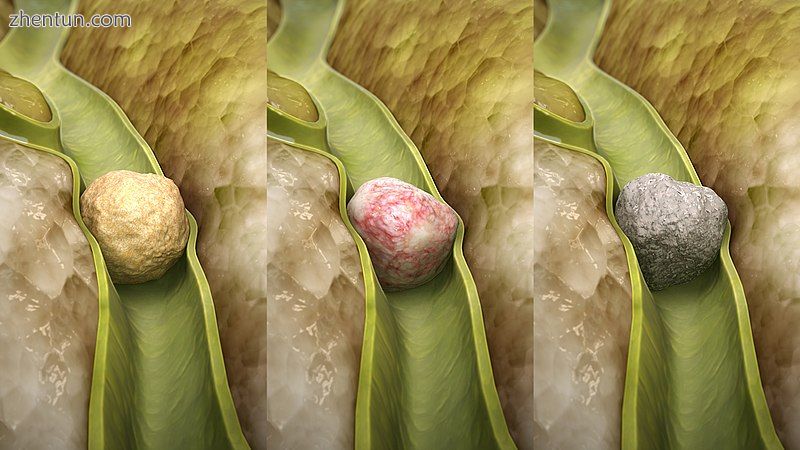
从左至右:胆固醇石,混合石,色素石。
胆结石的组成受年龄,饮食和种族的影响。根据其组成,胆结石可分为以下几种:胆固醇结石,色素结石和混合结石。理想的分类系统尚未定义。
胆固醇结石
胆固醇结石的颜色从浅黄色到深绿色,棕色或粉笔白色不等,呈椭圆形,通常单生,长2至3厘米,每一个通常都有一个微小的深色中心点。要进行此类分类,它们必须含有至少80%重量的胆固醇(或根据日本分类系统为70%)。胆固醇结石在35%至90%的结石中。
颜料石
胆红素(“色素”,“黑色颜料”)结石很小,呈黑色(通常呈黑色),通常数量很多。它们主要由胆汁中发现的胆红素(不溶性胆红素色素聚合物)和钙(磷酸钙)盐组成。它们的胆固醇含量不到20%(根据日本的分类系统为30%)。胆红素结石占结石的2%至30%。
混合石
混合的(棕色色素结石)通常含有20-80%的胆固醇(根据日本分类系统,则为30-70%)。其他常见成分是碳酸钙,棕榈酸酯磷酸盐,胆红素和其他胆汁色素(胆红素钙,棕榈酸钙和硬脂酸钙)。由于它们的钙含量,它们通常在射线照相下可见。它们通常继发于胆道感染,其导致β-葡萄糖醛酸苷酶的释放(由受损的肝细胞和细菌引起),后者水解胆红素葡萄糖醛酸苷并增加胆汁中未结合的胆红素的量。 4%至20%的石头混合在一起。
胆结石的大小和形状可以变化,从小到沙粒到大到高尔夫球。 胆囊可能包含单个大石头或许多小石头。 假石,有时称为污泥,是胆囊内可能存在的浓稠分泌物,可单独存在或与完全形成的胆结石一起存在。
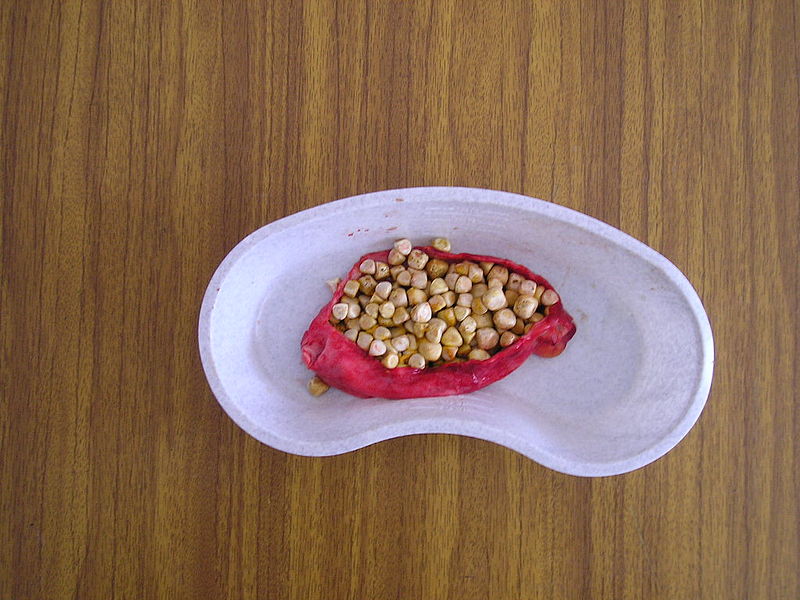
胆囊打开显示小胆固醇胆结石

胆结石的X射线断层摄影术
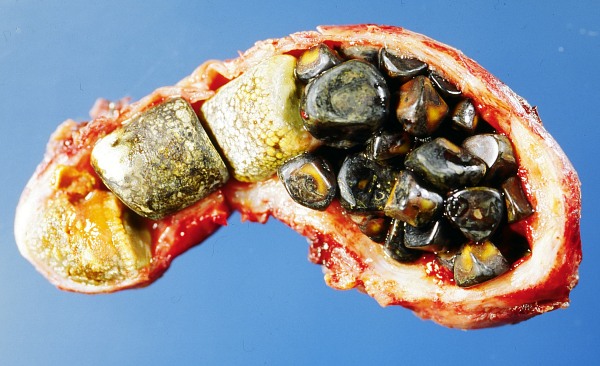
较大的黄色石头主要是胆固醇,而绿色至棕色的石头主要由胆汁色素组成
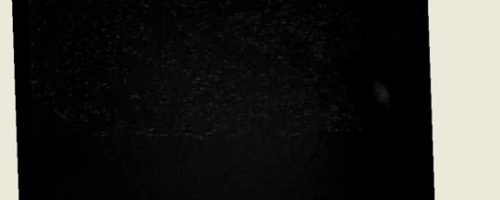
胆结石的CT图像
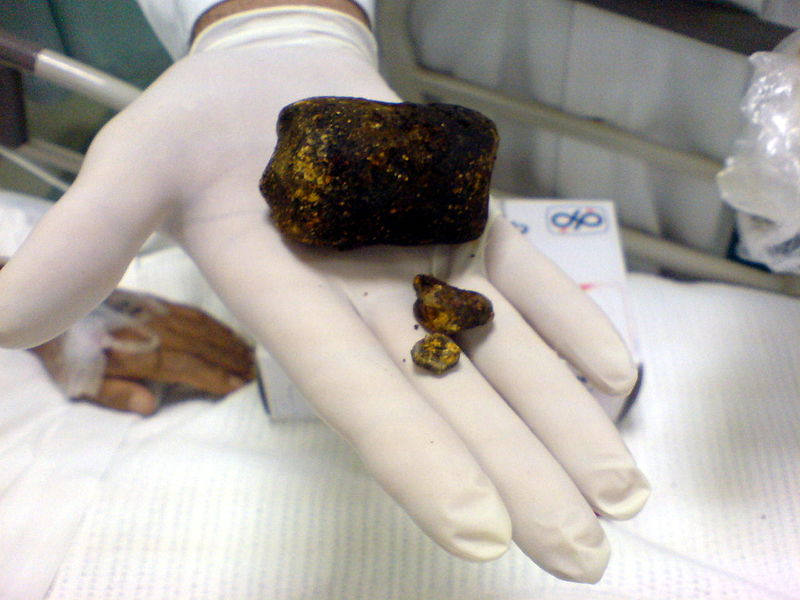
大胆结石
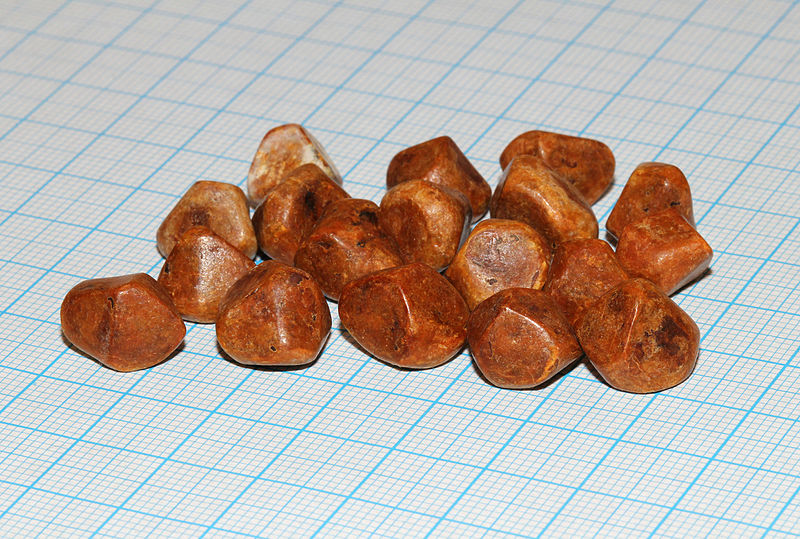
大量由胆固醇组成的小胆结石
诊断
诊断通常通过腹部超声确认。 使用的其他成像技术是ERCP和MRCP。 血液检查可能会发现胆结石并发症。
在胆囊发作期间,体格检查通常会发现墨菲氏征阳性。
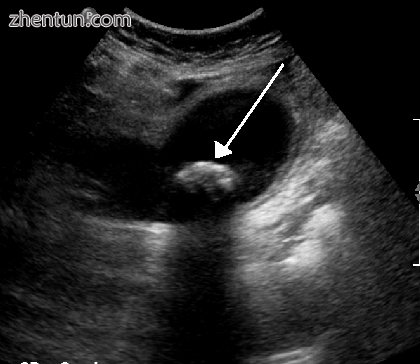
超声检查可见,一块1.9厘米的胆结石撞击胆囊的颈部并导致胆囊炎。 有4毫米胆囊壁增厚。
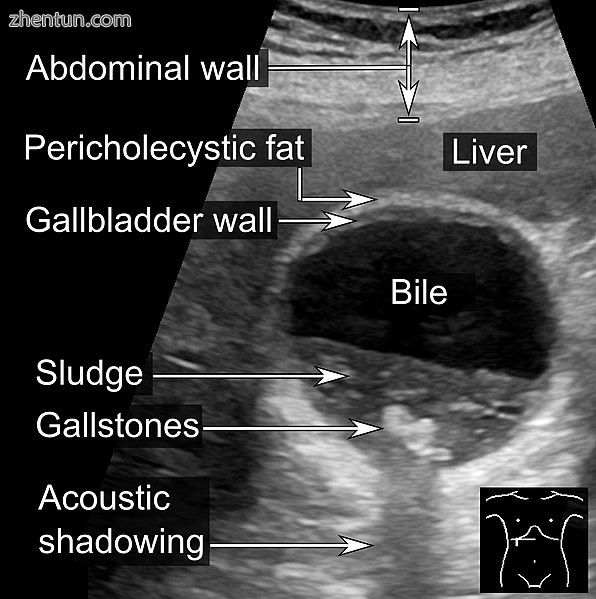
胆汁淤泥和胆结石。 胆囊壁边界线增厚。
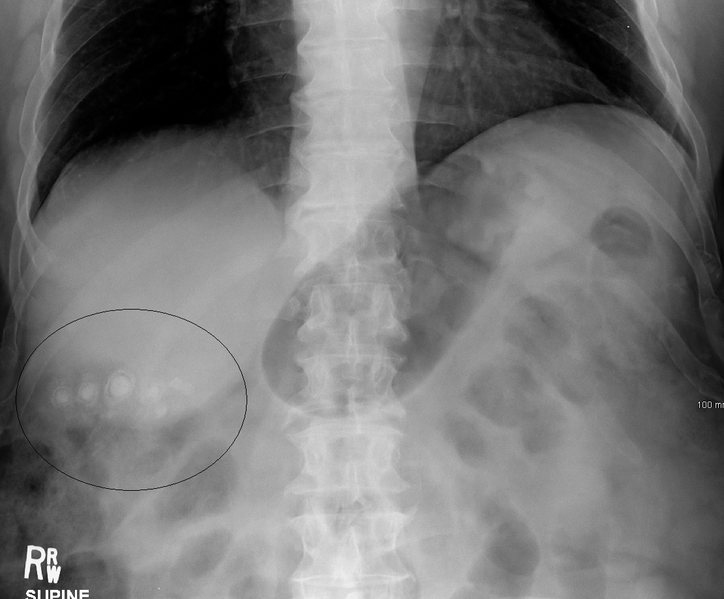
X线平片可见胆结石
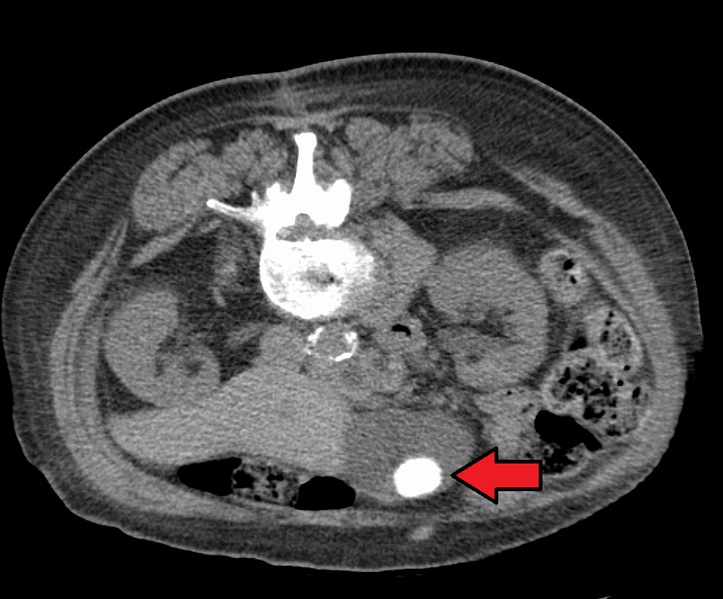
CT显示大胆结石
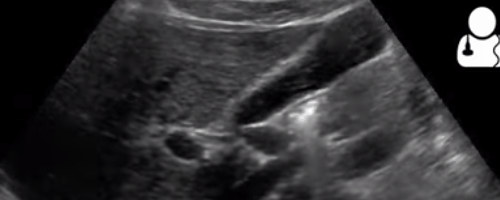
正常的胆囊超声检查会引起肠蠕动,形成结石的假象
预防
通过进行足够的运动来保持健康的体重,并饮食富含纤维的健康饮食,可能有助于预防胆结石的形成。
药物熊去氧胆酸(UDCA)似乎可以防止减肥过程中形成胆结石。减肥过程中的高脂饮食也似乎可以预防胆结石。
治疗
外科
胆囊切除术(切除胆囊)有99%的机率消除胆石症的复发。缺乏胆囊可能对许多人没有负面影响。但是,有一部分人口(介于10%至15%之间)发展为一种称为“胆囊切除术后综合症”的疾病,可能导致恶心,消化不良,腹泻和腹痛发作。
胆囊切除术有两种手术选择:
开腹胆囊切除术是通过右下肋骨下方的腹部切口(开腹术)进行的。康复通常需要住院3至5天,释放后一周恢复正常饮食,释放后几周恢复正常活动。
1980年代引入的腹腔镜胆囊切除术是通过3到4个用于照相机和仪器的小刺孔进行的。术后护理通常包括当日放行或一晚住院,然后是几天的家庭休息和止痛药。
医疗类
胆固醇胆结石有时可与经口摄取的熊去氧胆酸溶解,但此人可能需要多年服用这种药物。 但是,一旦停止用药,胆结石可能会复发。 内镜逆行胰胆管造影术(ERCP)后,内镜逆行括约肌切开术(ERS)有时可缓解胆结石阻塞胆总管。
传统药物
胆结石可以作为屠宰肉类动物的重要副产品,因为在某些文化的传统医学中,特别是在传统中药中,胆结石可用作解热剂和解毒剂。 珍贵的胆结石通常来自古老的奶牛,在中国被称为牛肝石或牛黄(牛黄)。 就像钻石矿一样,一些屠宰场会仔细检查工人的胆结石盗窃行为。
参考
Quick, Clive R. G.; Reed, Joanna B.; Harper, Simon J. F.; Saeb-Parsy, Kourosh; Deakin, Philip J. (2013). Essential Surgery E-Book: Problems, Diagnosis and Management: With STUDENT CONSULT Online Access. Elsevier Health Sciences. p. 281. ISBN 9780702054839.
"Gallstones". NIDDK. November 2013. Archived from the original on 28 July 2016. Retrieved 27 July 2016.
Lee, JY; Keane, MG; Pereira, S (June 2015). "Diagnosis and treatment of gallstone disease". The Practitioner. 259 (1783): 15–9, 2. PMID 26455113.
Ansaloni, L (2016). "2016 WSES guidelines on acute calculous cholecystitis". World Journal of Emergency Surgery : WJES. 11: 25. doi:10.1186/s13017-016-0082-5. PMC 4908702. PMID 27307785.
Internal Clinical Guidelines Team (October 2014). "Gallstone Disease: Diagnosis and Management of Cholelithiasis, Cholecystitis and Choledocholithiasis. Clinical Guideline 188": 101. PMID 25473723.
"Complications". nhs.uk. Retrieved 13 May 2018.
"Treatment for Gallstones". National Institute of Diabetes and Digestive and Kidney Diseases. November 2017.
editors, Ronnie A. Rosenthal, Michael E. Zenilman, Mark R. Katlic (2011). Principles and practice of geriatric surgery (2nd ed.). Berlin: Springer. p. 944. ISBN 9781441969996. Archived from the original on 2016-08-15.
Global Burden of Disease Study 2013, Collaborators (22 August 2015). "Global, regional, and national incidence, prevalence, and years lived with disability for 301 acute and chronic diseases and injuries in 188 countries, 1990-2013: a systematic analysis for the Global Burden of Disease Study 2013". Lancet. 386 (9995): 743–800. doi:10.1016/s0140-6736(15)60692-4. PMC 4561509. PMID 26063472.
GBD 2013 Mortality and Causes of Death, Collaborators (10 January 2015). "Global, regional, and national age-sex specific all-cause and cause-specific mortality for 240 causes of death, 1990-2013: a systematic analysis for the Global Burden of Disease Study 2013". Lancet. 385 (9963): 117–71. doi:10.1016/s0140-6736(14)61682-2. PMC 4340604. PMID 25530442.
Acalovschi, Monica; Blendea, Dan; Feier, Cristina; Letia, Alfred I.; Raitu, Nadia; Dumitrascu, Dan L.; Veres, Adina (2003). "Risk factors for symptomatic gallstones in patients with liver cirrhosis: a case-control study". The American Journal of Gastroenterology. 98 (8): 1856–1860. PMID 12907344.
National Institute of Diabetes and Digestive and Kidney Diseases (2007). "Gallstones" (PDF). Bethesda, Maryland: National Digestive Diseases Information Clearinghouse, National Institutes of Health, United States Department of Health and Human Services. Archived from the original (PDF) on 2010-12-05. Retrieved 2010-11-06.
Heuman DM, Mihas AA, Allen J (2010). "Cholelithiasis". Omaha, Nebraska: Medscape (WebMD). Archived from the original on 2010-11-20. Retrieved 2010-11-06.
"Gallstones (Cholelithiasis) Clinical Presentation: History, Physical Examination". emedicine.medscape. Archived from the original on 2016-11-14. Retrieved 2016-11-14.
Fitzgerald JE, Fitzgerald LA, Maxwell-Armstrong CA, Brooks AJ (2009). "Recurrent gallstone ileus: time to change our surgery?". Journal of Digestive Diseases. 10 (2): 149–151. doi:10.1111/j.1751-2980.2009.00378.x. PMID 19426399.
Roizen MF and Oz MC, Gut Feelings: Your Digestive System, pp. 175–206 in Roizen and Oz (2005)
Koppisetti, Sreedevi; Jenigiri, Bharat; Terron, M. Pilar; Tengattini, Sandra; Tamura, Hiroshi; Flores, Luis J.; Tan, Dun-Xian; Reiter, Russel J. (2008). "Reactive Oxygen Species and the Hypomotility of the Gall Bladder as Targets for the Treatment of Gallstones with Melatonin: A Review". Digestive Diseases and Sciences. 53 (10): 2592–603. doi:10.1007/s10620-007-0195-5. PMID 18338264.
Ortega RM, Fernández-Azuela M, Encinas-Sotillos A, Andrés P, López-Sobaler AM (1997). "Differences in diet and food habits between patients with gallstones and controls". Journal of the American College of Nutrition. 16 (1): 88–95. doi:10.1080/07315724.1997.10718655. PMID 9013440. Archived from the original on 2008-07-20. Retrieved 2010-11-06.
Medicine, Institute of; Board, Food Nutrition; Intakes, Standing Committee on the Scientific Evaluation of Dietary Reference; Water, Panel on Dietary Reference Intakes for Electrolytes and (2005). 4 Water | Dietary Reference Intakes for Water, Potassium, Sodium, Chloride, and Sulfate | The National Academies Press. p. 124. doi:10.17226/10925. ISBN 978-0-309-09169-5.
Tsai, C.-J.; Leitzmann, M. F.; Willett, W. C.; Giovannucci, E. L. (2005-06-01). "Dietary carbohydrates and glycaemic load and the incidence of symptomatic gall stone disease in men". Gut. 54 (6): 823–828. doi:10.1136/gut.2003.031435. ISSN 1468-3288. PMC 1774557. PMID 15888792.
Misciagna, Giovanni; Leoci, Claudio; Guerra, Vito; Chiloiro, Marisa; Elba, Silvana; Petruzzi, José; Mossa, Ascanio; Noviello, Maria R.; Coviello, Angelo; Minutolo, Marino Capece; Mangini, Vito; Messa, Caterina; Cavallini, Aldo; Michele, Giampiero De; Giorgio, Italo (1996). "Epidemiology of cholelithiasis in southern Italy. Part II". European Journal of Gastroenterology & Hepatology. 8 (6): 585–93. doi:10.1097/00042737-199606000-00017. PMID 8823575.
Choices, NHS. "Should you lose weight fast? - Live Well—NHS Choices". www.nhs.uk. Archived from the original on 2016-02-16. Retrieved 2016-02-16.
Commissioner, Office of the. "Safety Information—Xenical (orlistat) capsules". www.fda.gov. Archived from the original on 2016-06-11. Retrieved 2016-06-18.
Wang HH, Liu M, Li X, Portincasa P, Wang DQ (2017). "Impaired intestinal cholecystokinin secretion, a fascinating but overlooked link between celiac disease and cholesterol gallstone disease". Eur J Clin Invest (Review). 47 (4): 328–333. doi:10.1111/eci.12734. PMID 28186337.
Trotman, Bruce W.; Bernstein, Seldon E.; Bove, Kevin E.; Wirt, Gary D. (1980). "Studies on the Pathogenesis of Pigment Gallstones in Hemolytic Anemia". Journal of Clinical Investigation. 65 (6): 1301–8. doi:10.1172/JCI109793. PMC 371467. PMID 7410545.
Endocrine and Metabolic Disorders: Cutaneous Porphyrias, pp. 63–220 in Beers, Porter and Jones (2006)
Thunell S (2008). "Endocrine and Metabolic Disorders: Cutaneous Porphyrias". Whitehouse Station, New Jersey: Merck Sharp & Dohme Corporation. Retrieved 2010-11-07.
M. A. Cahan, M. A.; L. Balduf; K. Colton; B. Palacioz; W. McCartney; T. M. Farrell (2006). "Proton pump inhibitors reduce gallbladder function". Surgical Endoscopy. 20 (9): 1364–1367. doi:10.1007/s00464-005-0247-x. PMID 16858534.
Kan, He-Ping; Guo, Wen-Bin; Tan, Yong-Fa; Zhou, Jie; Liu, Cun-Dong; Huang, Yu-Qi (2014-10-09). "Statin use and risk of gallstone disease: A meta-analysis". Hepatology Research. 45 (9): 942–948. doi:10.1111/hepr.12433. ISSN 1386-6346. PMID 25297889.
Preiss, David; Tikkanen, Matti J.; Welsh, Paul; Ford, Ian; Lovato, Laura C.; Elam, Marshall B.; LaRosa, John C.; DeMicco, David A.; Colhoun, Helen M. (2012-08-22). "Lipid-modifying therapies and risk of pancreatitis: a meta-analysis". JAMA. 308 (8): 804–811. doi:10.1001/jama.2012.8439. ISSN 1538-3598. PMID 22910758.
Experimental investigation of the flow of bile in patient specific cystic duct models M Al-Atabi, SB Chin…, Journal of biomechanical engineering, 2010
Channa, Naseem A.; Khand, Fateh D.; Khand, Tayab U.; Leghari, Mhhammad H.; Memon, Allah N. (2007). "Analysis of human gallstones by Fourier Transform Infrared (FTIR)". Pakistan Journal of Medical Sciences. 23 (4): 546–50. ISSN 1682-024X. Archived from the original on 2011-08-24. Retrieved 2010-11-06.
Kim IS, Myung SJ, Lee SS, Lee SK, Kim MH (2003). "Classification and nomenclature of gallstones revisited" (PDF). Yonsei Medical Journal. 44 (4): 561–70. doi:10.3349/ymj.2003.44.4.561. ISSN 0513-5796. PMID 12950109. Retrieved 2010-11-06.
Gallstones—Cholelithiasis; Gallbladder attack; Biliary colic; Gallstone attack; Bile calculus; Biliary calculus Archived 2011-02-07 at the Wayback Machine Last reviewed: July 6, 2009. Reviewed by: George F. Longstreth. Also reviewed by David Zieve
Stokes, Caroline S.; Gluud, Lise Lotte; Casper, Markus; Lammert, Frank (2014-07-01). "Ursodeoxycholic Acid and Diets Higher in Fat Prevent Gallbladder Stones During Weight Loss: A Meta-analysis of Randomized Controlled Trials". Clinical Gastroenterology and Hepatology. 12 (7): 1090–1100.e2. doi:10.1016/j.cgh.2013.11.031. ISSN 1542-3565. PMID 24321208.
Jensen (2010). "Postcholecystectomy syndrome". Omaha, Nebraska: Medscape (WebMD). Archived from the original on 2010-12-23. Retrieved 2011-01-20.
Zackria, R; Waheed, A (January 2019). "Postcholecystectomy Syndrome". PMID 30969724.
National Health Service (2010). "Gallstones — Treatment". NHS Choices: Health A-Z—Conditions and treatments. London: National Health Service. Archived from the original on 2010-11-14. Retrieved 2010-11-06.
"Interview with Darren Wise. Transcrip". Omaha, Nebraska: Medscape (WebMD). Archived from the original on 2010-11-21. Retrieved 2010-11-06. |